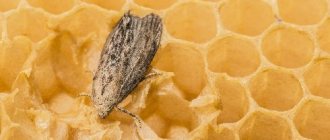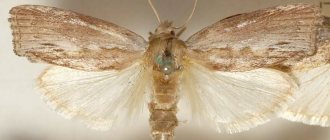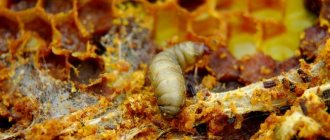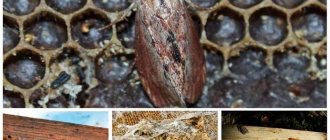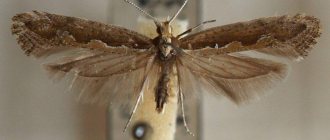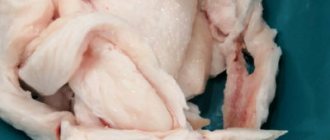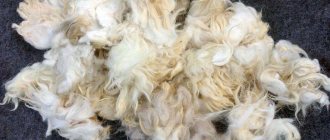The wax moth (also known as the bee moth) is an insect with a full cycle of transformation. It is a moth-like butterfly that leads a predominantly crepuscular lifestyle. The insect lays eggs in a bee hive, the caterpillars emerging from them feed on honey, wax and beebread, and often on bee offspring. They cause significant harm to agriculture, destroying bee colonies and hives, and destroying honey. Wax moth larvae are used in folk medicine because they accumulate beneficial substances in the body that are obtained from honeycombs and honey. Wax moth waste products, extracts from it, and tinctures are also used to treat various diseases.
What is wax moth?
The wax moth is a lepidopteran insect belonging to the Moth family. The butterfly is a pest of honey bees and lives near them. Females are much larger, have a body length of up to 35 mm and a wingspan of up to 32 mm. Male moths reach 13 mm in length, and their wingspan is no more than 23 mm.
| The article was verified by medical expert Vladimir Aleksandrovich Plisov |
The front wings of the moth are brown with a grayish tint, and the rear edge is brownish-yellow. Often there are individuals colored violet-gray. On the upper surface of the fore wings, females have brown spots, while males have red-brown spots. The body of the butterfly is beige. The hind wings are light ash. They have shading along the edge that sets off the main color. The brown or gray head with a short proboscis is elongated and clearly visible. The digestive organs and oral apparatus of adults are not developed. Adults do not feed, but exist due to the nutrients accumulated during the larval stage. The moth's lifespan is short: females live up to 12 days, and males - up to 26. Therefore, the only threat that the moth poses to the farm is the laying of larvae in the hives.
Types of wax moth
The Ognevka family includes two similar species that are often confused even by experienced beekeepers: the large wax moth and the small wax moth. These insects belong to different genera. Both butterflies parasitize bee hives, but the larvae of the lesser wax moth are not used in folk medicine, because it is believed that their bodies do not contain a sufficient amount of biologically active substances.
| Type of moth | External structure of an adult individual, dimensions | Eggs, place of laying | Larval stage | Doll |
| Great wax moth | The size of the female is from 13 to 35 mm, the wingspan is from 18 to 32 mm. The size of the male is 9-13 mm, the wingspan is no more than 23 mm. The forewings are wide, brownish-gray, have brown spots, and are colored yellowish along the edges. | The eggs are oval, light beige, almost white, size from 0.35 to 0.5 mm. On average, there are 300 eggs in one clutch; fertility, according to various estimates, is from 1500 to 300 eggs in a lifetime. Eggs are laid mainly in moans, next to honey and pollen. | The larva is beige, has first a yellow and then a dark brown head, 8 legs, body length - 18 mm. It is extremely voracious, feeding on the entire contents of the hive, including bee offspring, as well as unhatched larvae of its species. Prefers darker cells. By making moves, it damages the mediastinum of the honeycombs, because eats tunnels from all sides. | The pupa is initially yellowish, then turns brown. The pupation process takes about 14 days; if wintering is necessary, it continues for a long time until a suitable temperature is reached. Cocoons are 14-16 mm long, arranged in groups. |
| Lesser wax moth | The size of the female is from 7 to 12 mm, the maximum wingspan is 23 mm. Males are even smaller: 4.5-9 mm, wingspan up to 17 mm. The front wings are narrow, light-colored with spots, overlap each other at the ends, and are folded like a roof. The wings are generally more elongated, pointed, and the color can vary from light yellow to dark brown. The head is flattened and has a yellow spot. | The eggs are round, less often oval, ranging in size from 0.2 mm to 0.35 mm, colored light yellow. The average clutch is about 400 eggs. The female lays eggs mainly in the cracks of the hive, on the walls, on the floor, and much less often in the honeycombs. | The larva is very similar in appearance to the larva of a large wax moth, only the size differs: it reaches 12 mm, less often 17 mm. Makes passages only on one side of the honeycomb and does not damage the mediastinum. The basis of the diet is death, bee excrement, various remains at the bottom of the hive and waste products. They consume much less wax. | The pupa is white. Pupation occurs within two weeks. The cocoons are silky, 9 to 13 mm long, located singly, most often at the bottom or in the corners of the hive. |
Often beekeepers have difficulty identifying the type of moth, because... The size of butterflies varies depending on nutrition, weather conditions, population size, quality and quantity of honeycombs, and temperature conditions. In addition, the larvae of many other species of the moth family are similar to the larvae of wax moths. They do not have healing properties and may be more dangerous. The measures to combat them also differ.
Wax moth larvae
The moth lays eggs in portions mainly on the walls of the cells of honeycombs with fresh pollen or honey, less often - on the bottom of the hive, walls and in cracks. The butterfly gets inside at night when the bee colony is in a sleepy state. The eggs are light beige or white in color, oval in shape, up to 0.5 mm long and up to 0.35 mm wide. At one time, a female wax moth is capable of laying 300 eggs, and in her entire life - approximately 1500. Within 5-8 days, the clutch matures, and then a small light-colored larva with a yellowish head and a body length of about 1 mm appears. Soon it grows into a white caterpillar with a brown, hard, chitinous head and eight legs. The length of the caterpillar reaches 18 mm. It is covered with soft long hairs, sparsely located on the sides and on the back.
Wax moth larvae
Caterpillars feed very actively; their diet includes:
- honey;
- wax;
- royal jelly;
- honeycomb;
- propolis;
- beebread;
- bee offspring;
- ripening wax moth eggs;
- waste products of other caterpillars;
- remains of cocoons.
In the first hours of life, the larva does not show much activity. It passively feeds on wax, honey and bee pollen, but very quickly becomes mobile. The parasite makes passages in the honeycombs, entwines them with poutine, and eats the larvae and eggs of bees.
During 1-2 months of development, the moth caterpillar molts 10 times. It can damage hundreds of hive cells, lead a family of bees to decline and even forced migration. Due to special digestive enzymes, wax moths can digest the most inaccessible substances for other animals. They process chitin and wax, becoming saturated with a large number of useful chemical compounds. The larvae accumulate them in their body for further nutrition at the adult stage.
After 20 (less often - 50-60) days, the caterpillar finds a gap or crack in the hive, or gnaws out a special hole. There the process of pupation takes place. The pupa is about 14-16 mm long (depending on the sex of the future butterfly). The case initially has a light, straw-yellow color, and then darkens, acquiring a dark brown color. Usually the transformation occurs in about 2 weeks, however, if the eggs were laid in the fall, the wax moth waits out the cold in the pupal stage and emerges from the cocoon in the spring of next year.
MK Muftic
Mahmud Kamal Muftic (1925-1975) Photo: MK Muftic – author of scientific works on the digestive enzyme of wax moth larvae
Mahmud Kamal Muftic (MK Muftic 1925-1975) - Bosnian biochemist, published about 40 articles on bacteriology (including tuberculosis) in medical journals around the world. He is a co-author of several patents owned by the German pharmaceutical company Schering AG (now Bayer AG). From the end of 1940 to the beginning of 1960, MK Muftic worked as a doctor and researcher in several countries of the Middle East (Egypt, Iran, Saudi Arabia). Since 1962 worked at the Tuberculosis Research Institute in Schleswig-Holstein, West Germany. Since the late 1960s, he has been employed in the biochemistry laboratory at the University of Lausanne in Switzerland and collaborated with the biochemistry department at Trinity College Dublin.
Modern studies of wax moth larvae extract, conducted at the Institute of Cell Biophysics of the Russian Academy of Sciences, confirm the existence in the high-molecular fraction of acidic serine protease (cerase enzyme), capable of dissolving cell membranes. According to researchers from the Institute of Cell Biophysics of the Russian Academy of Sciences, it is the proteolytic enzyme, serine protease, that plays a leading role in the resorption of blood clots and plaques in blood vessels and lung tissue, as well as in the regeneration of scar tissue after a heart attack.
A major contribution to the study of the medicinal properties of wax moth belongs to the Moscow cardiologist and homeopath S. A. Mukhin. Even in his youth, a folk remedy made from wax moth larvae helped him cope with his own illness - tuberculosis. In his works devoted to the treatment of cardiovascular diseases, S. A. Mukhin was able to scientifically substantiate and prove the prospects of using wax moth larvae extract in the treatment of atherosclerosis, cardiosclerosis, angina pectoris and myocardial infarction, as well as tuberculosis and senile diseases.
Wax moth waste products
In folk medicine, not only the wax moth larvae themselves are used for treatment, but also their excrement. The caterpillar secretions contain many useful compounds, since due to a unique set of enzymes they break down beeswax, process beebread, honey and royal jelly. The chemical composition of the waste products of the bee moth is very rich, it includes:
- Flavonoids are a group of biologically active phenolic substances that are found in plant materials and cannot be produced by the human body. They are considered vital and must be consumed in food to normalize metabolism. Flavonoids activate enzyme systems and create favorable conditions for their work. These biologically active compounds improve the condition of capillaries, strengthening their walls, increase the elasticity of red blood cell membranes and normalize the degree of blood viscosity.
- Steroids are highly active organic compounds that play an important role in fat metabolism. They prevent the formation of cholesterol plaques and their attachment to the walls of blood vessels. These substances ensure the integrity of the cell plasmalemma and regulate lipid and calcium metabolism.
- Irioids are formed during the biotransformation of plant alkaloids, and therefore have a wide spectrum of action. They are characterized by antibacterial and anti-inflammatory properties. The compounds have a positive effect on the cardiovascular system, as they are able to stabilize smooth muscle tone, regulating blood pressure. Irioids have an antioxidant effect, preventing the formation of tumors.
Due to the high content of active components, wax moth waste products are used to treat a wide range of diseases. Most often, alcohol tinctures are used for treatment.
Honeycombs affected by wax moths
Mechnikov I. I.
Mechnikov Ilya Ilyich (1845-1916) Photo: Mechnikov I. I. - the first researcher of the medicinal properties of wax moth
Mechnikov Ilya Ilyich (1845-1916) - Russian scientist Nobel laureate in physiology and medicine in 1908 “For his work on immunity.” Among I. I. Mechnikov’s numerous awards is the Copley Medal of the Royal Society of London, an honorary doctorate from the University of Cambridge, and he is also a member of the French Academy of Medicine, an honorary member of the St. Petersburg Academy of Sciences and Moscow University, and a member of the Swedish Medical Society. Mechnikov is one of the founders of evolutionary embryology, the discoverer of phagocytosis and intracellular digestion, the creator of the phagocytic theory of immunity, and the founder of scientific gerontology. Since 1887, head of the laboratory at the Pasteur Institute in Paris.
Mechnikov’s idea about the ability of wax moth larvae to destroy the membranes of tuberculosis bacteria formed the basis for a large series of studies by the Russian immunologist Professor S.I. Metalnikov. Metalnikov experimentally proved and substantiated that the high immunity of wax moth larvae to a number of microorganisms pathogenic for humans (causative agents of tuberculosis, diphtheria, tetanus, plague, etc.) is due to a specific enzyme - cerase, which breaks down wax.
Beneficial properties of wax moth
The larvae and secretions of wax moths have many pharmacological properties, due to which they can be used for the prevention and treatment of various pathological conditions. Biologically active substances of bee moth have a positive effect on the body.
They are characterized by the following beneficial properties:
- the hypotensive effect is manifested due to the effect on the width of the lumen of blood vessels (their expansion and elimination of increased tone);
- antimicrobial property is manifested by the ability to suppress bacterial infections;
- immunomodulatory effect is based on the activation of cells of the immune system, the general strengthening of the immune system, the formation of an adequate response to the penetration of pathogenic microorganisms;
- the antioxidant property of compounds contained in wax moth helps protect human cells from the effects of aggressive free radicals and peroxide oxidants;
- antitumor effect helps to cope with existing malignant tumors, suppressing their tissue respiration and growth, prevents the emergence of new tumors and metastasis (formation of secondary foci);
- the anti-tuberculosis effect of wax moth helps to effectively fight tuberculosis and is associated with the presence of the enzymes cerrase and lipase, which dissolve the cell membrane of the causative agent of the disease - Koch's bacillus;
- fungicidal activity suppresses the development of fungal microflora, so wax moth can be used to treat mycoses of the skin and nails.
Extracts and tinctures of bee moth larvae and their metabolic products are used to prepare homeopathic remedies. Due to their complex of beneficial properties, they can be prescribed as an additional therapy for diabetes and gynecological diseases.
Indications for use
Wax moth can be prescribed for various pathologies. Due to the fact that the caterpillars of this insect contain many active chemical compounds, and preparations from them are made in various dosage forms, the use of the butterfly in medicine is practically unlimited. It is indicated for the following disorders:
- Arterial hypertension.
- Malfunctions in the conduction system of the heart (blockade of the right bundle branch).
- Atherosclerosis.
- Thrombosis of the upper and lower extremities.
- Inflammatory processes of peripheral vessels (endarteritis).
- Tuberculosis (with complex treatment together with other medications).
- Pancreatic dysfunction and dyspepsia caused by this disorder.
- Diabetes mellitus of any type as part of complex therapy.
- Complications of diabetes mellitus, including diabetic polyneuropathy, retinopathy.
- Erectile dysfunction, premature ejaculation.
- Various external bacterial infections.
- Seborrheic dermatitis.
- Eczema.
- Lichens and other mycoses of the skin and nail plates.
- Infertility.
To correct violations, it is necessary to individually select the dosage and use only properly prepared preparations based on wax moth. It is strongly recommended that before use, consult with a specialist regarding possible contraindications and changes in the optimal dose of the drug.
Metalnikov S. I.
Metalnikov Sergey Ivanovich (1870-1946) Photo: Metalnikov S.I. - author of the name of the digestive enzyme of wax moth larvae: cerase
Metalnikov Sergei Ivanovich (1870-1946) - Russian scientist: biologist, zoologist, immunologist. Published more than 250 scientific papers in the field of comparative physiology of invertebrates, applied microbiology and immunology in Russian and Western European languages. Some of Metalnikov's works opened up new areas of research. In 1907–1908 worked in the laboratory of I. I. Mechnikov at the Pasteur Institute in Paris. Since 1919, he has been a permanent employee of the Pasteur Institute, where he studied the immunity of invertebrates (primarily insects) and the connection between immunity and the activity of the nervous system. The founder of psychoneuroimmunology, a new field of medicine. Author of the famous book “The Problem of Immortality and Rejuvenation in Modern Biology” (1924), dedicated to the phenomenon of aging of the body.
You can find many publications on the Internet, including on Wikipedia, in which the existence of the cerase enzyme is questioned and all authors of scientific papers on the medicinal properties of wax (bee) moth larvae are called “persons not known in either medical or biological circles.” " If the authors of such publications do not know the names of Mechnikov, Metalnikov and other scientists, as well as numerous publications (list of published scientific articles) in authoritative scientific publications, then a logical question arises - what relation do such authors have to medical and biological circles?
In addition to Metalnikov (the author of a large series of publications on the immunity of wax moth larvae: Metalnikov, 1906, 1907, 1908, 1915, 1921; Metalnikov, 1907, 1908, 1920, 1921, 1935) an enzyme preparation that has a destructive effect on tuberculosis bacteria and has high lipolytic activity in relation to the lipids of Mycobacterium tuberculosis (Koch's bacillus), Mankiewicz E. was isolated from the larvae of the great wax moth (Mankiewicz, 1949; 1952). The antimicrobial effect of wax moth larvae extract against Mycobacterium tuberculosis was also confirmed in the works of other authors (Olivier, 1947; Kuzniecow and Wojciechowski, 1950; Paszewski, 1959).
A large series of studies of the cerase enzyme was carried out by the Bosnian biochemist MK Muftic (Mahmud Kamal Muftic) at the Tuberculosis Research Institute (Borstel Center) in Schleswig-Holstein (Germany) and the Biochemical Laboratory at the University of Lausanne (Switzerland). Scientific work of MK Muftic on the study of the enzyme cerase and its activity against Mycobacterium tuberculosis in the period 1955-1970. published in authoritative scientific journals around the world (British Journal of Tuberculosis, Enzymologia, Tubercle, Indian Journal of Medical Sciences, Pathologia and Microbiologia, The Japanese journal of tuberculosis, etc.).
Contraindications
An absolute contraindication for the use of medicines made from the bee moth or its excrement is individual intolerance. It can manifest itself in the form of gastrointestinal disorders (nausea, vomiting, indigestion), and allergies.
Other conditions under which wax moth use is not recommended:
- Children under 18 years of age, since there is not enough information about the safety of using such drugs in children;
- Pregnancy and lactation, since it is unknown whether the active substances can pass into breast milk and how they affect the baby in the womb. For expectant mothers, such drugs can only be prescribed by a specialist, and the administration should be carried out under his supervision.
It is important to understand that when treating serious diseases such as diabetes, oncology, tuberculosis, the help of doctors cannot be neglected. You should combine various pharmacological drugs with wax moth products, and consult your doctor about the compatibility of such therapy.
How to make a tincture of larvae at home
The offspring of wax moths, which have not yet pupated, but have already left the protective shells (eggs), are used as raw materials. Only at this stage does the larvae’s body produce the necessary substances. It is recommended to use the ratio of components: 10 g of larvae, 100 g of alcohol.
To preserve the properties of the medicine, it is prepared in a glass container. The tincture is left for 1 month in a cool and dark place. When the product is ready, it needs to be strained. Storage duration – 3 years.
Wax moth treatment
Wax moth extracts serve as the basis for the preparation of various medications, which can be used to alleviate the condition of tuberculosis, diabetes, disorders of the cardiovascular system and many other problems.
Tuberculosis
Tuberculosis develops when the body is infected with mycobacterium - the tuberculosis bacillus. The most common type is pulmonary tuberculosis, but there may also be other types of disease (bones, skin, digestive organs). The disease is characterized by extremely severe symptoms with a large number of complications, a long course, which is accompanied by a significant decrease in the quality of life. Often advanced forms lead to death. For treatment, special anti-tuberculosis drugs have been created, and preparations from wax moth caterpillars can be used as an auxiliary therapy.
Biologically active substances of the bee moth help suppress the development of Koch's bacillus. They stimulate the body's natural immune response and exhibit an adaptogenic effect. Insect larvae contain lipase, an enzyme that can effectively dissolve lipid membranes, catalyzing the fractionation of fats that make up the membranes. Another enzyme, cerrase, is unique. Only wax moths can produce it. The enzyme selectively acts on the tuberculosis bacillus, causing destruction of its cell wall. In this regard, the use of moth larvae is very effective in anti-tuberculosis therapy.
Gynecology
Extracts of the greater wax moth are used to treat gynecological problems. Due to the effect of chemical compounds on the body’s hematopoietic system, obstetricians and gynecologists often recommend taking tinctures and extracts of moth to treat anemia during pregnancy in certain trimesters. The components of the composition have a positive effect on red blood cells, increase hemoglobin levels and strengthen the body as a whole.
Substances contained in the insect help improve fertile function, therefore they are used to eliminate infertility. They normalize ovarian function, restore the normal monthly cycle and ovulation. In addition, thanks to its antitumor properties, the large wax moth inhibits the development of tumor diseases of the uterus and ovaries (polycystic disease, fibroids, endometriosis).
Cardiovascular system, hypertension
Wax moth tinctures have a positive effect on blood pressure and pulse pressure. The complex action of flavonoids and steroids causes relaxation of smooth muscle fibers of central and peripheral vessels and expansion of their lumen. The spasm and excessive load on the heart are relieved, which with hypertension works too hard and gets tired. The risk of such dangerous complications as:
- myocardial infarction;
- arrhythmia;
- tachycardia;
- heart dyssynchrony.
Bee moth larvae and their metabolic products not only prevent the development of arterial hypertension, but also prevent the formation of cholesterol plaques. Cholesterol penetrates into the damaged area of the endothelium (outer lining) of blood vessels, compaction appears, the vessels gradually lose their elasticity and atherosclerosis develops. This disease negatively affects the overall health; hardening of blood vessels leads to a narrowing of their lumen. They may eventually become clogged. Steroids and other beneficial compounds in the wax moth prevent cholesterol from being deposited as plaque.
Insect flavonoids are effective in treating varicose veins. Varicose veins are caused by inflammation of the venous walls, it is accompanied by unpleasant painful sensations, a feeling of heaviness and stiffness, as well as swelling, changes in the color of the skin, up to cyanotic (cyanotic). The use of wax moth alleviates the symptoms of the disease and reduces inflammation. The metabolic effect of drugs from this insect is manifested in the fact that butterfly extracts stop the progression of a serious disease by eliminating the damaging factor (for example, a malfunction of the immune system).
Biologically active compounds contained in bee moth normalize the functioning of the hemostasis system and gradually improve blood flow. This property is widely used for the prevention and treatment of thrombosis. The formation of blood clots can be caused by various reasons and is very dangerous, so it is important to prevent blood clots from forming in healthy veins and arteries.
For men
Wax moth is used to enhance erection and eliminate potency problems. Most often, the main cause of erectile dysfunction is insufficient blood flow to the penis. The active ingredients of larvae tinctures have the following positive effects:
- blood flow in the pelvic area is stimulated, sufficient filling of the cavernous bodies of the penis with blood is ensured, thereby maintaining a stable, long-lasting erection;
- the hormonal activity of the testes is activated, and the cells of the testes (testes) synthesize more testosterone, which is responsible for fertility and sexual desire;
- The production of sperm is normalized, they become more active, which increases their chance of fertilizing an egg, and the quantitative and qualitative composition of sperm improves.
Bee moth quickly relieves inflammation in chronic and bacterial prostatitis. Drugs based on it have a general analgesic effect, which facilitates the course of the disease and allows for more effective therapy. Strengthening the immune system promotes a speedy recovery and minimizes relapses.
In case of prostate adenoma, insect extracts reduce the rate of development of tumors, slow down the pathological process, allowing for timely surgical intervention or complex drug treatment.
Diabetes
Greater wax moth is used to correct severe metabolic disorders, including endocrine ones, including type 1 and type 2 diabetes mellitus. In diabetes, human cells do not receive enough glucose, because either the interaction of insulin with them is disrupted, or insulin is not produced by the pancreas.
The biologically active components of the bee moth larvae contribute to the normalization of metabolism, i.e., the metabolic process. They help the pancreas function properly and increase glucose absorption in non-insulin-dependent diabetes. Due to the constant hyperglycemia that accompanies this endocrine disease, the tissues suffer from a lack of nutrients. Diabetes is chronic, so there is a high risk of severe complications. Taking tinctures of the great wax moth reduces the risk of developing the following consequences:
- increased fragility of blood vessels, external and internal hemorrhages;
- damage to central and peripheral nerve fibers (neuritis);
- ophthalmological disorders: retinopathy, cataracts;
- dysfunction of the excretory system (nephropathy);
- decreased joint mobility, as well as the amount of joint fluid, which causes friction and pain.
Taking products based on this moth significantly improves the well-being of diabetes mellitus and prevents the occurrence of unpleasant complications.
Oncology
As part of complex therapy, wax moth is used to treat any tumors. Active compounds that are contained in the waste products of the larvae and in themselves show good results in suppressing the proliferation of tumor cells.
Substances with redox activity disrupt cellular respiration and stop cancer metastasis in the later stages, which has a beneficial effect on the patient’s quality of life and on his prognosis for high-quality neoplasms. Therefore, cell division and tumor growth slow down. The antitumor effect is also manifested in
Greater wax moth can be prescribed for cancer of all organ systems. Due to its adaptogenic effect, it mobilizes the body’s forces and directs them to fight the tumor, local improvements occur, and well-being is normalized.
Homeopathy
Wax moth extracts can be used to make homeopathic medicines. Due to the high concentration of natural chemical compounds that have a whole range of beneficial pharmacological properties, homeopathic treatment with this insect is very effective and safe. Processed parts of the beehive, such as bee bread, dead fruit, honey, wax and pollen, are completely natural, therefore remedies prepared using homeopathy methods are prescribed for various diseases.
External use
The antibacterial and fungicidal beneficial properties of the greater wax moth are very well expressed. If pathogenic microorganisms have been introduced into an open wound, it is advisable to treat it externally with tinctures and ointments created on the basis of Bee Moth. They trap bacteria on the surface, preventing them from penetrating deeper, so inflammation is only local and goes away very quickly. In this case, disinfection occurs quickly, and the addition of a secondary infection and the development of sepsis are excluded.
With fungal infections of the skin, the barrier function of the skin is disrupted and immunity is significantly reduced. Wax moth effectively fights fungi, allowing you to shorten long-term treatment by several times. It can be used to eliminate various lichens (shingles, ringworm, etc.), as well as other mycoses. Positive dynamics are also observed when using the butterfly to relieve the symptoms of typical skin diseases: dermatitis, eczema.
What wax moth preparations exist?
In folk medicine, a large number of different medicinal forms of wax moth are known. They are found in the form of tinctures and extracts. Ointments and creams for external use are also produced. In the pharmaceutical industry, the insect is used to produce tablets and granules. A variety of release forms allows you to individually select the appropriate product.
- Wax moth tincture is a liquid based on alcohol, honey, water or oil; the tincture is obtained without heating, but by infusing for a long time.
- Wax moth extract involves the use of ingredients in a strictly defined proportion, while the necessary beneficial substances are isolated from the moth, which can then be used to prepare other dosage forms.
- Tablets and granules are most convenient to take orally, because... they do not need to be chewed and can be accurately dosed; they are produced by pharmaceutical companies and often contain lactose and fructose.
- Ointments and creams are suitable for external application, except for the biologically active components of the Greater wax moth, since they contain vegetable or animal fats.
Cooking recipes
Wax moth tincture
To make an alcohol tincture of wax moth or its metabolic products, you need to take 200 grams of the infused product per 1 liter of alcohol or vodka. The larvae or their excrement are poured with ethanol in one concentration or another, after which the liquid is infused for 12 days in a dark, ventilated room. The tincture must be shaken regularly. Then the solid part is filtered, and the solution is diluted with 1 liter of clean water - the tincture is ready.
The honey tincture is prepared as follows: you need to mix 50 grams of wax moth larvae, 200 ml of 10% propolis and 150 g of honey. The mixture is infused for a week and then taken in liquid form. After the honey has crystallized, it is advisable to melt it in a water bath before use.
Wax moth extract
To prepare the extract, you need to take 10 parts of 70% alcohol and 1 part of wax moth larvae. The larvae are placed in a glass jar and filled with alcohol, then left for two weeks, protecting the container from direct sunlight. Immediately before use, the extract should be dissolved in liquid (tea, water, cow's or goat's milk).
Ointment and cream
To make an ointment, it is necessary to prepare in advance an extract of 50 grams of larvae in alcohol, infused for 5 days. The resulting liquid is mixed with 400 grams of vegetable oils: 200 grams of St. John's wort oil and 200 grams of calendula oil. The mixture is thoroughly mixed until small fat droplets form, then 50 grams of beeswax and propolis are added. All this is heated in a water bath for 2 hours, then put in the refrigerator to harden.
What is the difference between a tincture and an extract?
These are different forms of the drug. The recipe for making the tincture is based on alcohol. In this case, the raw materials are not exposed to high temperatures, as is the case with a decoction, which allows for better preservation of beneficial substances.
The medicine is infused for a long period. The disadvantage of the tincture is the small number of positive properties.
The extract is more effective than the tincture. This is facilitated by the manufacturing technology used: multi-stage extraction is carried out in an extractor where the raw materials are regularly mixed. As a result, much more minerals, antioxidants, and enzymes are preserved.
Instructions for use for various diseases
| Disease | Dosage form | Mode of application |
| Tuberculosis | Setting or extract | 3 times a day, 3-4 drops per 10 kg of person’s weight. |
| Cardiovascular disorders | Tincture | 1 tablespoon 30 minutes before meals. |
| Tablets and granules | 1 tablet or granule three times a day 15 minutes before meals. | |
| Diabetes | Extract | Dilute 30-50 drops in a small amount of water. Take for at least 1 month 15 minutes before meals. |
| Gynecological diseases | Tincture or extract | 2-4 drops of extract, up to 5 drops of tincture per 10 kg of body weight. |
| Erectile dysfunction, prostatitis, infertility | Tincture, extract | 3-6 drops per 10 kg of body weight. |
| Skin diseases and mycoses | Cream and ointment | Apply a thin layer to damaged areas of the skin and leave for at least 1 hour. |
| Oncology | Tincture or extract | 10 drops 30 minutes before meals, taken twice a day. |
In each individual case, the dosage can be individual; it depends on the severity of the disease, medical history and accompanying symptoms. You should take this medicine with caution and consult your doctor about everything. When consuming the extract, it should always be diluted in a small amount of liquid. People who have problems with the liver, kidneys and gastrointestinal tract should avoid alcohol tinctures and choose tablet forms of wax moth and extracts.
Fire for the thyroid gland
The thyroid gland is responsible for the production of iodine-containing hormones. Disruption of its work is fraught with consequences for the whole organism. The most common diseases for which moth tincture is used: goiter, hypothyroidism, hyperthyroidism.
With regular use of the drug, the following effect is observed: restoration of hormone levels, normalization of redox processes, improvement of the emotional state, as well as fat, protein and carbohydrate balance. Patients who take the product note a rapid improvement in their well-being.
Reviews
People rate wax moth preparations as a very effective natural remedy against various diseases. They note the high biological activity of the drug, quick relief, and strengthened immunity.
Tatyana Markova, 38 years old
My father took wax moth extract to combat atherosclerosis. Due to cholesterol plaques, his blood pressure was constantly elevated, which once provoked a heart attack. The doctors insisted on a difficult and expensive operation, but I came across an extract of bee moth larvae and advised me to take it. A month later – positive dynamics! The father stopped choking, the shortness of breath went away, and his heart condition improved. We will continue to take the drug.
Alexey Shcheburov, 51 years old
Thanks to the tincture of large wax moth larvae, my normal potency returned. No expensive pharmaceutical drugs helped. I started taking the tincture 2 times a day in the morning for a month, and positive results appeared. It acts gently, and most importantly naturally!
Valeria Nikitina, 26 years old
Bee moth extract is an excellent drug; we take it every winter to boost our immunity. Among the advantages: it very powerfully stimulates natural immunity, there is no unpleasant taste. Of the minuses, I can name this: before use, it is better to check if there are any allergies to beekeeping products. During illness, it puts you on your feet very quickly, I also drink it for prevention during the flu period.
Features of the insect
What is wax moth? This insect is a small gray butterfly that, like bees, gets access to honey. Every professional beekeeper knows such an insect, because he already has experience in fighting the moth.
The fact is that wax (bee) moths have an odor that is very similar to the aroma of bee honey. As a result, the bees accept this butterfly as “one of their own”, because it also drinks honey from flowers.
Bee moth caterpillars are very voracious, so they are very effective in treating a variety of ailments.
What are the benefits of butterfly honey? This pest of bee habitats is often used as a highly effective folk remedy for various ailments.
Our ancestors learned the various healing properties of the honey butterfly in the 17th century. During this period, experienced healers used bee moth tincture to treat specific heart ailments.
